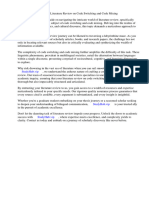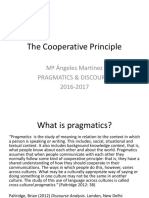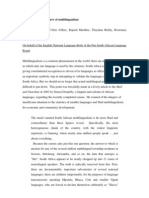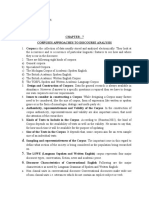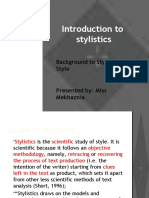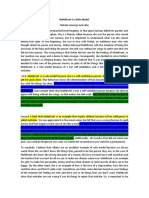Communicative Competence
Communicative Competence
Uploaded by
Levente JambrikCopyright:
Available Formats
Communicative Competence
Communicative Competence
Uploaded by
Levente JambrikOriginal Description:
Copyright
Available Formats
Share this document
Did you find this document useful?
Is this content inappropriate?
Copyright:
Available Formats
Communicative Competence
Communicative Competence
Uploaded by
Levente JambrikCopyright:
Available Formats
2.
Communicative competence (Hymes’ model; Canale and Swaine’s model; communicative
approach to English language teaching)
a) Linguistic competence
- Chomsky’s idea: the human capacity for language, as illustrated by a child’s acquisition of
the language around them, is not the product of general intelligence or learning ability, but an
innate, genetically determined feature of the human species we are born with a
considerable pre-programmed knowledge of how language works and require only minimal
exposure to activate our connection to the particular language around us a newborn’s brain
contains a Universal Grammar (UG) linguistic competence
- if we accept Chomsky’s idea, then language becomes more an object of biological
background and less social
- in this interpretation, similarities between language are more important and so outweigh the
differences
- this also means that language in itself is separated from other parts of communication such
as body language, intonation, or cultural knowledge Chomsky’s theories have a reductive
and constraining effect, excluding other factors of communication
b) Communicative competence
- communicative competence as described by Dell-Hymes in the 1960s (contrastive to
Chomsky): a person, who had only linguistic competence would be quite unable to
communicate. Even though they could produce grammatical sentences, it would be likely that
they would unconnected to the social situation in which they occur. Hymes suggests the
there are four types of knowledge needed for successful communication: possibility,
feasibility, appropriateness, and attestedness.
possibility: what is formally possible in a language, i.e. whether an instance conforms
to the rules of grammar and pronunciation Me going sleep now is not possible, but
I am going to sleep now is.
feasibility: this is a psychological concept concerned with limitations to what can be
processed by the mind. the rules of English allow for noun phrases to be expanded.
o The cheese was green.
o The cheese the rat ate was green.
o The cheese the rat the cat chased ate was green.
o The cheese the rat the cat the dog saw chased ate was green.
o The cheese the rat the cat the dog the man beat saw chased ate was green.
the last two sentences do not really work in communication because they
are hard to comprehend. They are not ungrammatical, but are hard to process.
appropriateness: conformity to social convention controversial.
o non-verbal communication: Important factors are the degree to which some
values are perceived to be absolute rather than culture specific, for example,
religious freedom, female modesty, and women’s rights, the degree to which a
society should respect ethnic difference among its members; and the degree to
which visitors should conform to the etiquette of their hosts.
o verbal communication: language creates our identities, so when speaking a
foreign language do we keep our own identity or should we conform to the
given language’s norms? Should, for instance, an Islamic speaker drop all
references to Allah in their speech and use God instead?
attestedness: whether…something is done. eg.: chips and fish it is possible (not
ungrammatical), feasible (it is easily processed and understandable), appropriate (it
does not contravene any sensitive social convention). still it does not really appear
in language in this form. solution now: corpus linguistics (computerized techniques
for searching large databanks, if something occurs in language)
c) Communicative approach
- communicative approach to English language teaching aims to develop learners’ capacity
to use the language efficiently
- tendency to neglect possibility (old-fashioned); and feasibility and attestedness (difficult to
grasp) and focus mainly on appropriateness resulted in distortion.
- the potential for other cultures to have an impact on English, or for learners to develop
separate identities within it, was neglected. ironic: the concept of communicative
competence does not assume that knowledge necessarily leads to conformity.
- concept of communicative competence shows how theories and rules may easily become
simplified in real life. however, it remains extremely powerful in language teaching.
- communicative competence includes three main competencies: grammatical competence,
sociolinguistic competence, and strategic competence. Canale and Swain’s theory of
communicative competence (alternative model to that of Hymes)
grammatical competence: knowledge of lexical items and rules of morphology,
syntax, syntax, sentence-grammar semantics, and phonology.
sociolinguistics competence:
o sociocultural rules of use: specifies ways in which certain propositions
and communicative functions are appropriate within a given
sociocultural context depending on contextual factors such as topic,
role of participants, setting and norms of interaction, as well as
appropriate attitude , register or style
o rules of discourse: combination of utterances and communicative
functions and not the grammatical well-formedness of a single
utterance nor the sociocultural appropriateness of a set of propositions
and communicative functions in a given context
strategic competence: verbal and non-verbal communication strategies called
into action to compensate for breakdowns in communication due to
performance variables or to insufficient competence.
You might also like
- Sociolinguistics and Language TeachingFrom EverandSociolinguistics and Language TeachingRating: 1 out of 5 stars1/5 (1)
- Assessing Speaking in Context: Expanding the Construct and its ApplicationsFrom EverandAssessing Speaking in Context: Expanding the Construct and its ApplicationsM. Rafael SalaberryNo ratings yet
- Meredith L Patterson A Biopunk ManifestoDocument5 pagesMeredith L Patterson A Biopunk ManifestoxeroxcandybarNo ratings yet
- 04-Communicative Competence and Analysis of Its ComponentsDocument10 pages04-Communicative Competence and Analysis of Its ComponentsJccd JccdNo ratings yet
- (Brandao de Carvalho, Joaquim) Lenition and FortitionDocument607 pages(Brandao de Carvalho, Joaquim) Lenition and FortitionLevente JambrikNo ratings yet
- Communicative CompetenceDocument4 pagesCommunicative CompetenceBilly Joe Ravago100% (1)
- English as a Foreign or Second Language: Selected Topics in the Areas of Language Learning, Teaching, and TestingFrom EverandEnglish as a Foreign or Second Language: Selected Topics in the Areas of Language Learning, Teaching, and TestingNo ratings yet
- Discourse analysis applied to english language teaching in colombian contexts: theory and methodsFrom EverandDiscourse analysis applied to english language teaching in colombian contexts: theory and methodsNo ratings yet
- Hymes Theory of Communicative CompetenceDocument2 pagesHymes Theory of Communicative CompetenceFilip RistićNo ratings yet
- Discourse Analysis and Second Language Writing - Wennerstrom Chap 01Document16 pagesDiscourse Analysis and Second Language Writing - Wennerstrom Chap 01MohamshabanNo ratings yet
- Literature Review On Code Switching and Code MixingDocument6 pagesLiterature Review On Code Switching and Code MixingafmzfxfaalkjcjNo ratings yet
- LinguisticsDocument14 pagesLinguisticsGlennmeloveNo ratings yet
- Communicative Competence in Second Language TeachingDocument12 pagesCommunicative Competence in Second Language TeachingRizka SNo ratings yet
- Guy Cook's Applied Linguistics: Chapter 3: Languages in The Contemporary World Dina BensureitiDocument29 pagesGuy Cook's Applied Linguistics: Chapter 3: Languages in The Contemporary World Dina BensureitiDina Bensreti100% (1)
- Seven Theories of SlaDocument2 pagesSeven Theories of SlaKristel CachaNo ratings yet
- DiglossiaDocument9 pagesDiglossiaWardani Dwi WNo ratings yet
- Applied Linguistics Lecture 1Document18 pagesApplied Linguistics Lecture 1Dina BensretiNo ratings yet
- PsycholinguisticsDocument24 pagesPsycholinguisticsMasum RahmanNo ratings yet
- SociolinguisticsWardhaugh CH 13Document17 pagesSociolinguisticsWardhaugh CH 13loviebabe100% (1)
- Ch. 1 Summary (HOLMES)Document4 pagesCh. 1 Summary (HOLMES)Carol SalmanNo ratings yet
- Sociolinguistics and Language Teaching HandoutDocument22 pagesSociolinguistics and Language Teaching HandoutSri RejekiNo ratings yet
- Psycholinguistics (Syllabus)Document4 pagesPsycholinguistics (Syllabus)razielkaNo ratings yet
- Multilingual Speech CommunitiesDocument9 pagesMultilingual Speech CommunitiesAris PetNo ratings yet
- 1Document9 pages1sumayya tariqNo ratings yet
- Intro To Sociolings 6 Final ReviewDocument65 pagesIntro To Sociolings 6 Final ReviewNel SweetieNo ratings yet
- An Introduction To Applied LinguisticsDocument30 pagesAn Introduction To Applied Linguisticspriya avaisNo ratings yet
- تاشير أمتحان نهائيDocument30 pagesتاشير أمتحان نهائيanmar ahmedNo ratings yet
- Communicative Language TeachingDocument8 pagesCommunicative Language TeachingBima Nusantara100% (1)
- Linguistic Register and Code SwitchingDocument6 pagesLinguistic Register and Code SwitchingRea Jane B. MalcampoNo ratings yet
- Subfields of Applied LinguisticsDocument29 pagesSubfields of Applied LinguisticsLaarni Airalyn CabreraNo ratings yet
- Language Choice (s1)Document12 pagesLanguage Choice (s1)Bagas TiranggaNo ratings yet
- Grices Cooperative PrincipleDocument22 pagesGrices Cooperative PrincipleMaría PérezNo ratings yet
- MultilingualismDocument8 pagesMultilingualismKayssia VenstarNo ratings yet
- CH 4Document27 pagesCH 4sthaboutusNo ratings yet
- Didactics SummaryDocument5 pagesDidactics SummaryDani SilvaNo ratings yet
- Communicative Competence in Teaching English As A Foreign LanguageDocument4 pagesCommunicative Competence in Teaching English As A Foreign LanguageCentral Asian StudiesNo ratings yet
- The Necessity of Grammar TeachingDocument4 pagesThe Necessity of Grammar TeachingDuc Nguyen MinhNo ratings yet
- Course Notes On Language and National DevelopmentDocument42 pagesCourse Notes On Language and National Developmentdammydave4No ratings yet
- Phonetics&PhonologyDocument4 pagesPhonetics&PhonologyCintia Reyes100% (1)
- The Use of Slang Amongst Undergraduate Students of A Malaysian Public UniversityDocument9 pagesThe Use of Slang Amongst Undergraduate Students of A Malaysian Public UniversityJOURNAL OF ADVANCES IN LINGUISTICS100% (1)
- 02 - History of Applied Linguistic SubirDocument14 pages02 - History of Applied Linguistic Subirapi-242290760No ratings yet
- Summary DiscourseDocument8 pagesSummary DiscourseDevi Selfiani Sabri100% (1)
- Discourse AnalysisDocument5 pagesDiscourse Analysisaldesierra100% (2)
- Key Terms in ELTDocument10 pagesKey Terms in ELTSalsabeel Nagi100% (1)
- Language and Its CharacteristicsDocument5 pagesLanguage and Its CharacteristicsRubeel SarwarNo ratings yet
- Chapter 11 - Yes-No Questions - The Grammar Book - Form, Meaning, and Use For English Language TeachersDocument22 pagesChapter 11 - Yes-No Questions - The Grammar Book - Form, Meaning, and Use For English Language TeachersHồ Quang TrungNo ratings yet
- 1 Stylistics (2) Master 2Document47 pages1 Stylistics (2) Master 2Safa Bzd100% (1)
- Cognitive Linguistic Vs Autonomous OneDocument6 pagesCognitive Linguistic Vs Autonomous OneLamiiaa Lagriba LagribaNo ratings yet
- Communicative CompetenceDocument7 pagesCommunicative CompetenceRogerio Azeredo100% (3)
- Summary of Book Techniques and PrincipleDocument12 pagesSummary of Book Techniques and PrincipleM. KarimiNo ratings yet
- Sociolinguistics (Essay)Document6 pagesSociolinguistics (Essay)Youniverse0% (1)
- BASICS OF PsycholinguisticsDocument6 pagesBASICS OF Psycholinguisticshusnain.y4827No ratings yet
- Solidarity and PolitenessDocument14 pagesSolidarity and PolitenessMega Nur Indah100% (1)
- Wardhaugh Chapter 4Document2 pagesWardhaugh Chapter 4Jude0% (1)
- An Introduction To SociolinguisticsDocument5 pagesAn Introduction To SociolinguisticsEria Wati RahmaNo ratings yet
- Sociolinguistics Full BookletDocument30 pagesSociolinguistics Full BookletAmad StrongmanNo ratings yet
- Chapter 2 Code Switching MixingDocument27 pagesChapter 2 Code Switching MixingSii Tiudd Bala Bala100% (1)
- TVP Sociolinguistic CoursebookDocument363 pagesTVP Sociolinguistic CoursebookNguyễn VânNo ratings yet
- Sociolinguistics Is The Science Which Deals With The Relationship Between LanguageDocument7 pagesSociolinguistics Is The Science Which Deals With The Relationship Between Languagelenin.undeadNo ratings yet
- Linguistics Micro & Macro Levels PDFDocument22 pagesLinguistics Micro & Macro Levels PDFMà Ř YãmNo ratings yet
- Simple AssessmentDocument6 pagesSimple AssessmentLevente JambrikNo ratings yet
- (Don Ringe, Ann Taylor) The Development of Old Eng (Book4You)Document629 pages(Don Ringe, Ann Taylor) The Development of Old Eng (Book4You)Levente Jambrik100% (1)
- Abracadabra - Sorcery and Witchcraft in European History by W. R. JonesDocument12 pagesAbracadabra - Sorcery and Witchcraft in European History by W. R. JonesLevente JambrikNo ratings yet
- Foudations of PhonologyDocument66 pagesFoudations of PhonologyLevente JambrikNo ratings yet
- Resume Cover Letter Examples For ReceptionistDocument8 pagesResume Cover Letter Examples For Receptionistc2kzzhdk100% (1)
- Provisional Timetable: Obuasi Senior High Technical SchoolDocument3 pagesProvisional Timetable: Obuasi Senior High Technical SchoolSamuel Owusu DonkoNo ratings yet
- BE Computer Engineering Syllabus 2019 CourseDocument3 pagesBE Computer Engineering Syllabus 2019 CourseMishra JiNo ratings yet
- SWASH Scoring GuideDocument2 pagesSWASH Scoring GuideSean KilleenNo ratings yet
- Blackbook ReportDocument5 pagesBlackbook ReportKaran Yalgukar19No ratings yet
- BrochureDocument2 pagesBrochureapi-460857910No ratings yet
- Fci Result 2012Document13 pagesFci Result 2012Sunil PatelNo ratings yet
- Grade 3 DLL MTB 3 q1 Week 2Document3 pagesGrade 3 DLL MTB 3 q1 Week 2Aziong Foto100% (2)
- Culture and Traditions of The Waray PeopleDocument2 pagesCulture and Traditions of The Waray PeopleKenRianNo ratings yet
- Diass Q2 Q1Document3 pagesDiass Q2 Q1Garcia NikiNo ratings yet
- WST111 Study Guide 2024Document30 pagesWST111 Study Guide 2024skyebanks2020No ratings yet
- Journal of Comparative Literature and Aesthetics, Vol. 44, No. 1, Spring 2021Document233 pagesJournal of Comparative Literature and Aesthetics, Vol. 44, No. 1, Spring 2021Viraj ShuklaNo ratings yet
- Children's Agency in Theory and in Practice Within Childhood StudiesDocument17 pagesChildren's Agency in Theory and in Practice Within Childhood StudiesZsuzsa MajorNo ratings yet
- REFERENCES LIST and In-Text CitationDocument4 pagesREFERENCES LIST and In-Text CitationRirin dinda FebriayuNo ratings yet
- A-13 BS Entrepreneurship - CBEMDocument7 pagesA-13 BS Entrepreneurship - CBEMJuliet Dechosa MajadasNo ratings yet
- Materi Mata Kuliah Filsafat IlmuDocument24 pagesMateri Mata Kuliah Filsafat IlmuUdilanNo ratings yet
- Maleficent Is A Role Model NCDocument2 pagesMaleficent Is A Role Model NCNatalia CamargoNo ratings yet
- Second Quarter Webinar DR Dadari BioDocument13 pagesSecond Quarter Webinar DR Dadari Bioapi-385504653No ratings yet
- AP 8 Lesson Plan 1st - 4th (2022-2023)Document75 pagesAP 8 Lesson Plan 1st - 4th (2022-2023)sulitsarah672No ratings yet
- Value of DisciplineDocument2 pagesValue of Disciplinecrazyguru64No ratings yet
- Your Jungle Guide To Chess Tactics Peter Prohaszka QCDocument826 pagesYour Jungle Guide To Chess Tactics Peter Prohaszka QCJuan100% (2)
- Engineering Mechanics: Statics: William F Riley Leroy D SturgesDocument1 pageEngineering Mechanics: Statics: William F Riley Leroy D SturgesJaswinderpal SinghNo ratings yet
- Weekly Home Learning Plan-2nd QuarterDocument4 pagesWeekly Home Learning Plan-2nd Quarterdivina bentayaoNo ratings yet
- Question Paper Subject-Mathematics For Class-12th Examination - 2024-25Document37 pagesQuestion Paper Subject-Mathematics For Class-12th Examination - 2024-25Lalitha SrinuNo ratings yet
- Day 3: MotivationDocument6 pagesDay 3: Motivationsoukainabenchekroun95No ratings yet
- Introduction HandoutDocument3 pagesIntroduction Handoutkouroshkutm7885No ratings yet
- Holiday Homework of Science Class 6Document5 pagesHoliday Homework of Science Class 6cfp4gtpa100% (2)
- 2018 OBE Implementation Guidebook v2Document56 pages2018 OBE Implementation Guidebook v2Vic Key100% (4)
- Mindfire Digital LLP Internship Cum PPO Recruitment Drive-Online Test On 13th Aug'2024 - 2025 BatchDocument7 pagesMindfire Digital LLP Internship Cum PPO Recruitment Drive-Online Test On 13th Aug'2024 - 2025 Batchritabrata2003.rrcNo ratings yet












